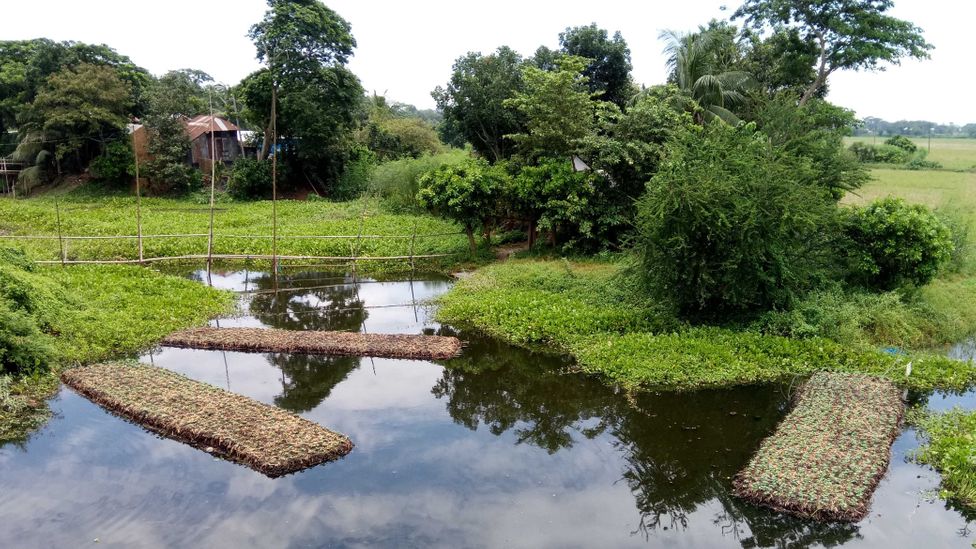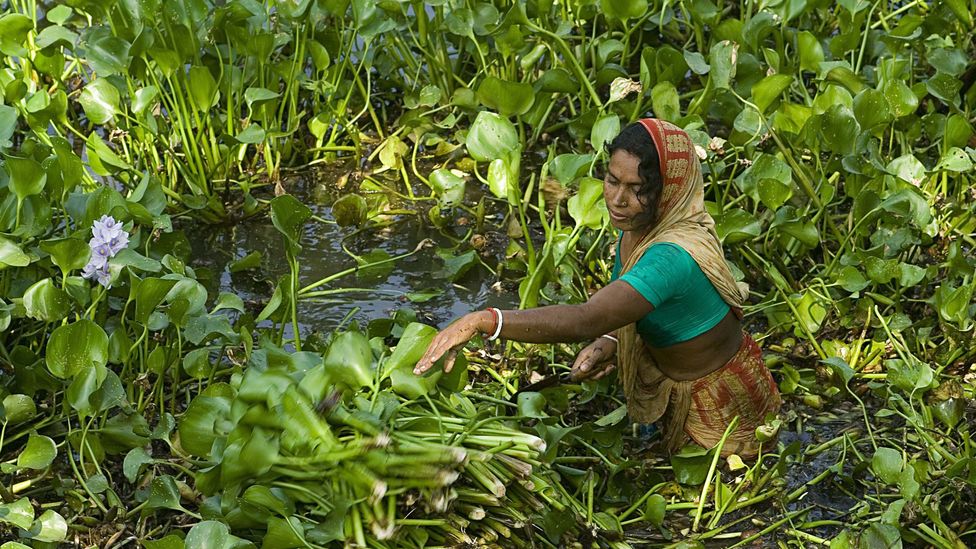https://www.bbc.com/future/article/20200910-the-remarkable-floating-gardens-of-bangladesh
Ripening squash, bitter gourd and okra loom over a mass of water hyacinth. Birds fly low over the surface of the water. Bijoy Kumar, a farmer in the low-lying Gopalganj district of Bangladesh, stands knee deep in water, tending to his plants. He and his family could not escape the rising waters in the volatile monsoons – so they abandoned the traditional rice crop. He turned instead to an eco-friendly practice that had been used by his ancestors in the southern flood plains, a traditional form of hydroponics, called floating vegetable gardens.
Bangladesh, by the fact it was formed by the alluvial plains of the Ganges-Brahmaputra river systems, is prone to floods and waterlogging. Fierce monsoons, Himalayan snow melt and severe cyclones exacerbate the problem for the country. Two-thirds of Bangladesh is wetland, criss-crossed by highly sedimented rivers that frequently change their course. Vast swathes of land in the country are under water for as much as eight months in a year, while seawater intrusion also makes much coastal land useless for growing crops.
This has made a great difference to my life. Now I have enough food in the floods – Bijoy Kumar
And yet agriculture is one of the most important contributors to the country’s GDP. Bangladesh is also one of the world’s poorest countries, where 48% of the 160-million-strong population is landless. The number of people displaced from their homes in Bangladesh because of climate change is predicted to rise to one in seven of the population by 2050. Some farmers are giving up agriculture and looking for alternative ways to make a living, while others find work at clothing factories or moving to farm shrimp.

As sea levels rise, a historic agricultural practice is offering respite to farmers who are losing their land
(Credit: Fahmida Akter)
Floating gardens are most common in the districts of Gopalganj, Barisal and Pirojpur. Here, during monsoons the farmers gather weeds like water hyacinth or paddy stalks, and place them on stagnant water, beating them into shape and making rafts. They plant seedlings on these organic beds, and place them in flooded parts of the villages.
It was something as common as having a small terrace garden in a city – Haseeb Irfanullah
Kumar and his family collected water hyacinth, building a rectangular raft out of it, and planted it with vegetable seedlings. The buoyancy of this floating garden allows it to rise with the water levels. “This has made a great difference to my life. Now I have enough food in the floods, and I can give some to help my neighbours and relatives as well,” he says.
This kind of soil-free cultivation also exists in different parts of the world, such as Dal Lake in Kashmir and Inle Lake in Myanmar, where people have adapted to living on the water. The UN’s Food and Agricultural Organization declared Bangladesh’s floating gardens to be a globally important agricultural heritage system in December 2015. These are landscapes that combine agricultural biodiversity, resilient ecosystems and cultural heritage.

Water hyacinth is an invasive weed in parts of Bangladesh, but now it is being used to form soil-free beds for the country's floating gardens
(Credit: Getty Images)
Dhaka-based Haseeb Irfanullah, an independent environment and climate change consultant, and former program coordinator at the International Union for Conservation of Nature (IUCN), says that his friends who lived in villages have grown up seeing their mothers and grandmothers make floating gardens. “It was something as common as having a small terrace garden in a city,” he says.
Anatomy of a floating garden
Farmers stack several compact layers of aquatic weeds like water hyacinth, duckweed or paddy stubs – the stubble of what remains after the rice grain has been harvested. They are helped usually by their families and neighbours. The weeds are allowed to rot, and then mixed usually with cow dung and silt. Crop seeds are placed in small balls called tema that are made out of peat soil, and wrapped in coconut fibre.
After a week, when seedlings are about 15cm high, they are transplanted to the floating garden beds. Traditionally, seeds of leafy vegetables, like red amaranth, are sown directly on the floating beds. They are then anchored with bamboo poles, so that they don’t drift away.
Continued at: https://www.bbc.com/future/article/20200910-the-remarkable-floating-gardens-of-bangladesh
Recommend this post and follow The Life of Earth
https://disqus.com/home/forum/lifeofearth/
https://chuckincardinal.blogspot.com/


No comments:
Post a Comment
Stick to the subject, NO religion, or Party politics